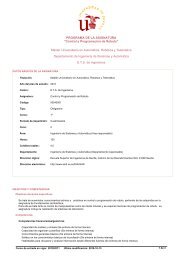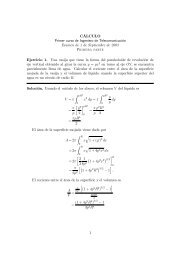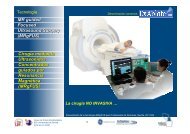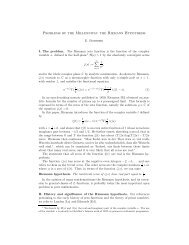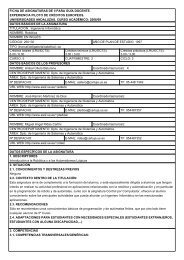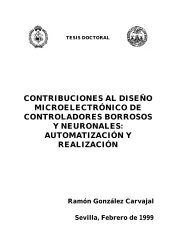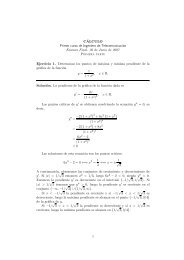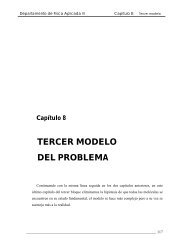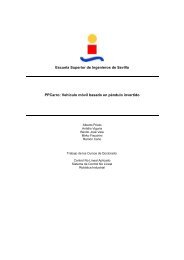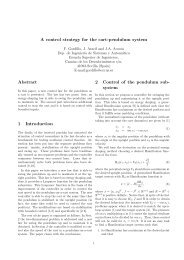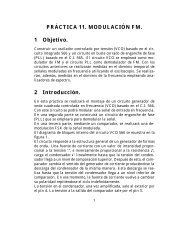The Oscillations Killer: a Mechanism to Eliminate ... - GIPSA-Lab
The Oscillations Killer: a Mechanism to Eliminate ... - GIPSA-Lab
The Oscillations Killer: a Mechanism to Eliminate ... - GIPSA-Lab
Create successful ePaper yourself
Turn your PDF publications into a flip-book with our unique Google optimized e-Paper software.
<strong>The</strong> <strong>Oscillations</strong> <strong>Killer</strong>: a <strong>Mechanism</strong> <strong>to</strong> <strong>Eliminate</strong> Undesired Limit Cyclesin Nonlinear Systems.Carlos Canudas-de-Wit, Javier Aracil, Francisco Gordillo and Francisco SalasAbstract— In this paper, we present a new mechanism, namedthe oscillation killer (OSKIL), intended for extinguish limitcycles that may occur as a consequence of: unexpected externaldisturbances, interactions with the environment, changes insystems set-points and physical parameters, etc. Examples ratefrom controlled systems with friction, <strong>to</strong> electrical networkswith varying loads and impedances. <strong>The</strong> proposed mechanismsis shown <strong>to</strong> be particulary adapted for nonlinear systemsdisplaying a local stable region with a stable limit set outsidethis local domain. <strong>The</strong> method is applied <strong>to</strong> the stick-slip limitcycle elimination in a system with dry friction.Index Terms— <strong>Oscillations</strong> cancellation, stabilization, nonlinearsystems.I. INTRODUCTIONIN a large class of nonlinear system, non-desired oscillationsand limit cycles can be produced as a result ofvarious fac<strong>to</strong>rs such as: external disturbances, interactionswith the environment, changes in systems physical parameters,variations of set-points, etc. Examples of such a type canbe found in mechanical systems, electrical networks, powersconverters, etc.One possible way <strong>to</strong> cope with such a problem is <strong>to</strong>redesign the control <strong>to</strong> avoid potential oscillations, but insome cases, it is more practical <strong>to</strong> “add” an outer loop<strong>to</strong> remove the oscillations by actuating over “external”parameters/signals such as: set-point values, normal forcemagnitudes, etc. <strong>The</strong> idea is, <strong>to</strong> bring back the systemoperation within the local stable domain where is designed<strong>to</strong> operated at. It is also implicit that those parameters/signalsshould be changed “provisorily” until the oscillations havebeen extinguished, but that they are required <strong>to</strong> re<strong>to</strong>ur <strong>to</strong>their nominal operational values thereafter. In this paper weintroduce such a mechanism, named here the OScillationKILler (OSKIL).<strong>The</strong>se ideas will of course not be applicable <strong>to</strong> any system,but <strong>to</strong> a particular class of systems covering a large numberof important examples including the ones mentioned above.<strong>The</strong>se are nonlinear systems displaying a local stable regionwith a stable limit set outside this local attraction domain. Inparticular, there is a generic situation for which this occurs:systems displaying a saddle-node bifurcation of periodicorbits [6], [5]. In this class of systems, two limit cyclesemerge at the bifurcation point, being one of them stableC. Canudas-de-Wit is with <strong>The</strong> <strong>Lab</strong>ora<strong>to</strong>ire d’Au<strong>to</strong>matique de Grenoble,UMR CNRS 5528, ENSIEG-INPG, B.P. 46, 38 402, ST. Martin d´Hères,FRANCE. Email: carlos.canudas-de-wit@inpg.fr.Javier Aracil, Francisco Gordillo and Francisco Salas are with theEscuela Superior de Ingenieros, Universidad de Sevilla, Camino de losDescubrimien<strong>to</strong>s s/n, 41092-Sevilla-SPAINwhile the other is unstable. If the system has an equilibriumpoint, its local stability is not affected by the emergence ofsuch limit cycles.<strong>The</strong> saddle-node bifurcation of periodic orbits is wellstudied in the literature. Although it is a local bifurcation, itis difficult <strong>to</strong> find analytical conditions for its occurrence, butit serves as a guide for simulation and control design. In thispaper we will focus in systems displaying such bifurcationalthough the ideas can be possibly applied <strong>to</strong> a larger classof systems.II. THE PROBLEMWe consider SISO closed-loop systems of the formẋ = Ax + g(x,u) (1)y = Cx (2)where A is a strictly stable (n × n) matrix, C is a vec<strong>to</strong>r,of dimensions (1 × n), g(x,u) is a nonlinear function, nonnecessarily smooth, with the property that g(0,u) = 0, andu is the system “parameter/signal”, that is responsible forpossible oscillations. We assume that the variation range ofu is between [u m ,u M ]. Let u be defined as,u = u 0 + ũwhere ũ is the error or discrepancy between u and thenominal operation value u 0 ∈ (u m ,u M ). <strong>The</strong> regulationmechanism, ˙ũ = ˙u, must assure that u is kept withinpre-specified domain [u m ,u M ]. <strong>The</strong>se values, although notmanda<strong>to</strong>ry 1 , may ordered as follows:u m < u b < u 0 < u Mwhere u b which describes a possible bifurcation point.Definition 1 (Nominal System): Let the nominal systembe defined from (1), with u = u 0 . That is with ũ = 0.{ ẋ = Ax + g(x,u0 )(3)y = CxA. Nominal System PropertiesIt is assumed that the nominal system (3) has the followingproperties:Property 1: Unique equilibrium. <strong>The</strong>re exist an uniquesolution, x ∗ for Ax ∗ +g(x ∗ ,u 0 ) = 0. In particular we assumethat x ∗ = 0.Property 2: Local stability. <strong>The</strong> equilibrium point x ∗ = 0is locally exponentially stable for every value of parameter1 See for instance the drive example in Section V where the bifurcationpoint lies above u 0 .
Fig. 1. Schematic representation of system trajec<strong>to</strong>ries for the nominalsystem (3). <strong>The</strong> local attractive set Ω r0 includes the unique equilibriumx ∗ = 0, and the invariant set M including the stable periodic orbit γ.u, i.e. there exist a closed-set Ω r0 Ω r0 = { x : ||x|| 2 ≤ r 0 , }including the equilibrium, x ∗ = 0, such that if x(0) ∈ Ω r0 ,then x(t) → 0, as t → ∞. We denote r 0 = r(u 0 ), thenominal radius associated with the nominal system (3).Property 3: Invariant set M. Assume that there exists aninvariant set, M ⊂ R n of (3), such that M ∩ Ω r0 is empty.For simplicity, we consider here hyper-spherics shapes, i.e.M = { x : r(u 0 ) < ||x|| 2 < ∞ } (4)M being open from above, M ∪ Ω r0 contains all possiblebounded values in R n . <strong>The</strong>n Ω r0 defines the attraction set<strong>to</strong> the origin, outside which oscillation may occur.Property 4: Closed stable orbits γ. Let γ(u 0 ) ⊂ M be aset of closed orbits indexed by the parameter u 0 associatedwith the unique (for a given u 0 ) periodic solutions x T (t) of(3) with period T . <strong>The</strong> periodic orbit γ(u 0 ) is thus the imageof x T (t) in the state space, defined byγ(u 0 ) = {x : x(t) = x T (t), 0 ≤ t ≤ T }We further assume, that γ(u 0 ) is attractive in the set M,or equivalently, that system (3) is asymp<strong>to</strong>tically orbitally(locally) stable as long as x(0) ∈ M.Properties of the nominal system are sketched by Figure 1With the assumption above, and using the definition (4),we have the following situation:{ 0 if x(0) ∈lim x(t) = Ωr0t→∞ γ(u 0 ) elsewhereNote that the size of Ω r0 can be enlarged by changing thevalue of u 0 .B. Behavior away from nominal operationExamples of systems of the form (1), may exhibit a richerbehavior away from the nominal operation value for u = u 0 .For instance system (1) is assumed <strong>to</strong> display a bifurcationpoint at u = u b . It is then assumed the following:Property 5: Global stability below u b . System (1) isglobally asymp<strong>to</strong>tically stable for all u ∈ [u m ,u b ).Property 6: Local stability in the set [u b ,u M ]. System(1) has the same properties 2 than the nominal system (3) forall u ∈ [u b ,u M ].2 <strong>The</strong> size of the local attraction domain may change as a function of thevalue of u.a) b) c)Fig. 2. Saddle-node bifurcation of periodic orbits. Fig. 2a it is showna state space where the system is globally stable; whereas is Fig. 2c theequilibrium is locally stable and it is surrounded by the two limit cyclesdescribed above. <strong>The</strong> bifurcation is produced in Fig. 2b where the two limitcycles come <strong>to</strong>gether and coalesce.Property 7: Problem solvability. <strong>The</strong>re exist at least onepath trajec<strong>to</strong>ry (in the bifurcation diagram) for u, such that:• a limit cycle reached under u = u 0 , can be extinguishedby bringing u below the value u b ,• there exists a re<strong>to</strong>ur path trajec<strong>to</strong>ry for u, from such aregion <strong>to</strong> its nominal value u 0 , such that the system iskeep within the local attraction domain of x = 0.Last property is needed for the solvability of the problem,and discussed further in the next subsection.C. Saddle-node bifurcation of periodic orbits<strong>The</strong> generic bifurcation diagram of a saddle-node bifurcationof periodic orbits is shown in Fig. 2. <strong>The</strong>se three graphsare parameterized by the bifurcation parameter, being Fig.2b the one corresponding <strong>to</strong> the bifurcation point.Assume that the system has a bifurcation parameter valuecorresponding <strong>to</strong> Fig. 2c and that it is originally at theequilibrium point. That means that the system is at thedesired equilibrium point. Assume also that a perturbationleads the system out of this point. If the perturbation is smallthe system remains in the attraction basin of this equilibriumand, thus, it recovers the desired state. But if the perturbationis large enough <strong>to</strong> leave the attraction basin then it will fallin the one of the stable limit cycle and, thus, the system willtend <strong>to</strong>wards this attrac<strong>to</strong>r and will oscillate.<strong>The</strong> shape of Fig. 2 suggests a way <strong>to</strong> recover the desiredequilibrium. Once the oscillating behavior is approachedthe action on the system should be such that it moves <strong>to</strong>the left changing the value of the bifurcation parameter u,tending <strong>to</strong>wards the bifurcation point u b . Once this point isslightly surpassed the system leaves the oscilla<strong>to</strong>ry mode andreturns <strong>to</strong> the equilibrium, but for a value of the bifurcationparameter different from the desired one. Thus, the last taskis <strong>to</strong> lead the value of the bifurcation parameter <strong>to</strong> thenominal value u 0 .Stated formally, the problem can be formulated as follows:Problem 1: Let x(0) = x 0 be any possible bounded valuein R n . Assume that system (1) fulfills all the propertiesdescribed previously, with u(0) = u 0 . <strong>The</strong> problem is <strong>to</strong>
Fig. 3. Shape of Hamil<strong>to</strong>nian function H given by (5) for u = 2 > u bdescribing the case where limit cycles may occur (left), and for case wherethe system is globally stable u = 1 < u b , (right).find a feedback law for u (or ũ) such thatlim t→∞ = 0, x(0) = x 0ũ(t) = 0, ũ(0) = 0limt→∞under the constraint u(t) ∈ [u m ,u M ], ∀t ≥ 0.III. EXAMPLE: A SECOND-ORDER HAMILTONIANSYSTEMWe consider a second-order Hamil<strong>to</strong>nian system with theHamil<strong>to</strong>n functionH = 1 2 (r2 − ur 4 + r 6 ) (5)where r 2 = x 2 1 + x 2 2. In Fig. 3 the shapes of H before andafter the bifurcation is produced are shown. Function H canbe associated with the dynamic system[ ] [ ][ ]ẋ1 −k1= Γ ∇x1 H dẋ 2 − 1 (6)Γ−k ∇ x2 H d[ ][ ]−k1= Γ Γx1. (7)−k Γx 2− 1 Γwhere Γ(x) = 1 − 2ur 2 + 3r 4 , and k > 0. This leads <strong>to</strong>ẋ 1 = x 2 − kΓ(x)x 1ẋ 2 = −x 1 − kΓ(x)x 2 ,which is a special case of (1), with[ ]−k 1A = , g(x,u) = kr 2 (2u − 3r 2 )−1 −kA. System properties with constant u[x1(8)x 2].System (6) belongs <strong>to</strong> a class which is an extension ofthe one studied in [1]. In this system, the limit cycles arecharacterized by circles of radius r. It can be seen fromEq. (8) that Ḣ ≤ 0 and this oscillation occurs for valuesof r such that Γ(r) = 0, that is for the roots of Γ(r) =1 − 2ur 2 + 3r 4 = 0, and they are given by:r 2 = u ± √ u 2 − 3. (9)3Bifurcation will occur for u 2 = 3. <strong>The</strong>n:• For u > √ 3 = u b the system exhibits two limit cycles(see for the stability discussion below): one unstable ofradiusru 2 = u − √ u 2 − 3(10)3and one stable of radiusrs 2 = u + √ u 2 − 3(11)3such that r s > r u .• For u < √ 3 = u b the origin is globally stable.Stability of the sets (equilibrium point and the orbit), can beanalyzed by introducing the Lyapunov function V = x T x =r 2 , and noticing that ˙V = −2kr 2 Γ(V ). Thus for all valuesof u < u b , we have Γ(V ) > 0, and hence ˙V ≤ 0. Wecan conclude that the only possible invariant set included in˙V = 0 is the equilibrium x ∗ = 0. Using LaSalle’s invarianceprinciple, it is seen that the system is globally asymp<strong>to</strong>ticallystable for values of 0 ≤ u < u b .Following the same type of reasoning, we can check thatwhen u > u b , Γ(V ) changes sign: it is negative for ru 2 rs 2 and for V < ru. 2 <strong>The</strong>refore,˙V > 0, in the domain ru 2 < V < rs, 2 and ˙V < 0 for V >rs 2 and for V < ru. 2 As a consequence, the set defined byV = rs, 2 or equivalent the set x 2 1 + x 2 2 = rs 2 becomes a localattrac<strong>to</strong>r for the solutions of (8), when x(0) is taken outsideΩ ru = {x : x T x ≤ ru}.2<strong>The</strong> above properties are true for any u ∈ [0, ∞), while forpractical reason, the range of variation of u may be restricted<strong>to</strong> u ∈ [u m ,u M ], where these two extremes values shouldrespect the order: 0 < u m < u b < u 0 < u M < ∞. Forthis particular example the following numerical values willbe used: u m = 0, u b = √ 3, u 0 = 3, and u M can take anysuitable value verifying u M > u 0 .Figure 4 shows the bifurcation diagram in the (r 2 ,u)plane. <strong>The</strong> upper (filled dots) curve describes the values of(r 2 ,u) where stable oscillation lies at, whereas the curvewith empty dots represent the unstable limit cycles. <strong>The</strong>dotted curve also represents an exact boundary of the local attractiondomain since we are dealing with a two-dimensionalsystem. From here we can also get some useful insight inhow <strong>to</strong> design a mechanisms <strong>to</strong> kill oscillations in the casethey appear.B. Adaptation loop designWe are only interested in the case where r ≥ 0 and u ≥ 0,with u M being any suitable value 3 . <strong>The</strong> following regulationmechanism is considered{−r − εũ if u > 0 or − r − εũ ≥ 0˙ũ =(12)0 elseu = u 0 + ũ (13)Notice that the switch in Eq. (12) prevents u <strong>to</strong> be negative:˙ũ is set <strong>to</strong> zero in the case u reaches u = 0, otherwise˙ũ = ˙u = −r − εũ would make ˙u < 0.3 <strong>The</strong> considered adaptation law can be modified <strong>to</strong> ensure that u M is anupper bound for u, for <strong>to</strong> make the presentation simpler, we assume thatany bounded u M is admissible.
This adaptation law is now shown <strong>to</strong> be globally stabilizethe point (x 1 = 0,x 2 = 0,u = u 0 ).Proposition 1: Consider system (8) controlled with thealgorithm (12)–(13). Assume that ε is small enough so thecurve Γ(r,u) = 0 does not intersect the line,r + ε(u − u 0 ) = 0.<strong>The</strong>n, every trajec<strong>to</strong>ry of system (8)–(12) starting in thequadrant r ≥ 0, u ≥ 0 tends <strong>to</strong> the unique equilibrium(0,0,u 0 ).Proof: Changing variables x 1 , x 2 in system (8) in<strong>to</strong>polar coordinates r, θ, we haveṙ = −krΓ(r,u) (14)˙θ = −1. (15)Since these equations are decoupled we just focus in Eq.(14).Assume for the moment u > 0 (remember that the switchin Eq. (12) prevents u <strong>to</strong> be negative). With u > 0, thesystem readsṙ = −krΓ (16)˙u = −r − ε(u − u 0 ). (17)Fig. 4 shows the isoclines of this system in the plane (r,u).<strong>The</strong> line r + ε(u − u 0 ) = 0 corresponds <strong>to</strong> ˙u = 0. <strong>The</strong>n,for the points below this line, ˙u > 0 (region Ω 3 in Fig. 4),while ˙u < 0 above the line. On the other hand, on the curveΓ = 0, the time derivative of r is equal <strong>to</strong> zero. In Fig. 4, Ω 2denotes the region where Γ < 0 (and, thus, ṙ > 0) and Ω 1 isthe region where Γ > 0 and, besides, ˙u < 0. It is clear thatthe set Ω 1 ∩Ω 3 is invariant since trajec<strong>to</strong>ries cross the curveΓ = 0 <strong>to</strong>wards the left and trajec<strong>to</strong>ries can not leave the firstquadrant since for r = 0, ṙ = 0. Moreover, with similararguments it can be seen that region Ω 3 is also invariant.Furthermore, trajec<strong>to</strong>ries will eventually leave region Ω 2since, in this region ∃γ 1 : ˙u < γ 1 < 0.Consider now the Lyapunov function candidateIts time derivative isV (u,r) = ur + ε 2 (u − u 0) 2 .˙V = −kur 2 Γ − (r + ε(u − u 0 )) 2 ,which is non-positive in the invariant region Ω 1 ∩ Ω 3 .Furthermore ˙V is zero only at the desired point.In order <strong>to</strong> apply LaSalle invariance principle <strong>to</strong> proof thestatement, it only remains <strong>to</strong> consider the technical problemassociated with the switch since its presence makes the fieldnon-differentiable. For this, let us analyze the motion whenu = 0. It is clear that for r > εu 0 , variable r will decrease(∃γ 2 : ṙ < γ 2 < 0). <strong>The</strong>refore the trajec<strong>to</strong>ry will eventuallyreach the segment r < εu 0 , u = 0. In this segment, ˙u > 0and the system quits the vertical axis and can not return <strong>to</strong>it since it enters region Ω 3 where ˙u > 0.r0O0Ω 1Γ = 0Ω 2εu 0Ω 3Fig. 4. Bifurcation diagram of the second-order Hamil<strong>to</strong>nian system in the(r, u)-plane and regions defined by the isoclines of system (16)–(17).Fig. 5. uu 0Block scheme of the oscillation killer control.IV. THE OSCILLATION KILLER (OSKIL) MECHANISMInspired in the heuristics of the previous Sections a generalstructure for the OSKIL controller can be defined. Itsstructure is shown in the block diagram in Figure 5. It iscomposed of following two main components:1) <strong>The</strong> oscillation detec<strong>to</strong>r, is a map from some freelychosen system output y <strong>to</strong> ξ. It should designed: <strong>to</strong>detect the frequency of the oscillations, <strong>to</strong> extract thebias if needed, and <strong>to</strong> generate a signal ξ reflectingthe oscillation amplitude. <strong>The</strong> aspects related <strong>to</strong> thefrequency detection are not treated in this paper.2) <strong>The</strong> saturated adaptation mechanism, is a dynamicmap from ζ <strong>to</strong> u, not necessarily smooth (commutationlaws may be used as well), and provides a correctionterm that is bounded such that u is keep within itsknown range of variation [u m ,u M ].<strong>The</strong> design of these components is not unique, but dependson the application at hand. An elementary choice was shownin the previous section, but this choice does not includes allpossible components, e.g. oscillation detec<strong>to</strong>r. One possiblestructure for the OSKIL mechanism is the following one:y f = F(s)y (18)ξ =∫ t+Tty 2 f(τ)dτ (19)˙ũ = Pu uMm{ψ(ξ,ũ,u 0 )} (20)u = u 0 + ũ (21)
<strong>The</strong> role of each of these component is:• Equation (18) defines a pre-filter F(s) used <strong>to</strong> extractthe bias and the main oscilla<strong>to</strong>ry component,• Equation (19) computes the RMS used <strong>to</strong> transform themain oscillation in<strong>to</strong> a continuous variable,• Equations (20)–(21) describes the saturated controller,where ψ(ξ,ũ,u 0 ) is the adaptation law, and Pu uMmis aprojection opera<strong>to</strong>r that ensures that the values of u willbe in the range [u m ,u M ].<strong>The</strong> rationality behind the equations (18)–(21) is as follows.Assume that for some reasons the system underconsideration has left the local attractive set Ω r0 , and as aconsequence the state vec<strong>to</strong>r x(t) has reached the stable orbit(limit-cycle) γ. If the output y(t) has been properly chosenso that the oscillations are reflected on that measure, we canthen assume that y(t) will be of the formy(t) = y 0 + A 0 cos(ω 0 t + ϕ 0 ) + · · · ,where y 0 is the bias component of the oscillation, A 0 andω 0 = 2πT , ϕ 0 are: the amplitude, frequency and phase, of themain oscilla<strong>to</strong>ry component.Using a filter of the formF(s) =K f s(s + ω 1 )(s + ω 2 )with ω 1 = ω 0 − ∆ω > 0, and ω 2 = ω 0 + ∆ω > 0.<strong>The</strong> value of K f and ∆ω are designed such that |F(jω 0 | ≈1, and frequencies away from ω 0 be filtered out. <strong>The</strong> outpu<strong>to</strong>f (18), can be approximated as: y f (t) ≈ A 0 cos(ω 0 t + ϕ 1 ).Equation (19) computes the RMS value of y f (t), yielding,ξ =∫ t+TtA 2 0 cos 2 (ω 0 τ + ϕ 1 )dτ ≈ A2 0T2≥ 0This signal reflects the magnitude of the oscillation and it issuited <strong>to</strong> control oscillations. Note that in this computation,the exact value of T is not manda<strong>to</strong>ry. For instance, if T isover estimated, the signal ξ will still reflecting the amoun<strong>to</strong>f oscillation in the output y. Similar arguments apply if|F(jω 0 | ≠ 1.Equations (20)–(21) are for the purpose of producing acontrol signals bounded in the range [u m ,u M ]. <strong>The</strong> valueof u should reflect the growth of ξ in this interval with theappropriate direction, with the property that if ξ → 0, thenu → u 0 . This can be obtained by a suitably adjusted linearstable filter with input saturation, as it will be shown in thenext example.V. MECHANICAL SYSTEMS WITH FRICTIONIn this section, we illustrate how the OSKIL can be used<strong>to</strong> eliminate limit cycles produced by friction in a speedcontrolled drive with dry friction. <strong>The</strong> parameter used <strong>to</strong>die off the oscillation is the reference velocity. Anotherexample of this kind is a drillstring system which has higherdimension. <strong>The</strong> actuation variable is the Weight-on-bit whichis the normal force used for the drilling operation, see moredetails in the companion paper [3].OSKIL++v ru PI 1PIJs−−Friction Fig. 6. Closed loop configuration of a drive with friction <strong>to</strong>gether with theOSKIL mechanism.v4.03.53.02.52.01.51.00.5HSNPO0.00.00 0.20 0.40 0.60 0.80 1.000.10 0.30 0.50 0.70 0.90Fig. 7. Bifurcation diagram in the (v, u) plane. <strong>The</strong> maximum valuesof (unstable) stable limit cycles are represented by (empty (◦)) filled (•)dots. Stable (unstable) equilibria are represented by solid (dashed) curves.(H=Hopf bifurcation, SNPO=Saddle-node of Periodic Orbits bifurcation).Consider a servo with friction controlled with a standardvelocity PI-control loop. Its closed loop representation <strong>to</strong>getherwith the OSKIL mechanism is shown in Fig 6, wherek i and k p represent the integral and proportional gains; Fis the friction force; v r is the reference velocity; u PI is theforce applied and v is the rotational velocity.<strong>The</strong> closed-loop equations of motion areuv˙v = 1 J (u PI − F) (22)˙u PI = k i (v r − v) − k p ˙v (23)ż = v − σ 0|v|g(v) z (24)F = σ 0 z + σ 1 ż + σ 2 v (25)with g(v) = F c +(F s −F c )e −(v2 /v 2 s ) . <strong>The</strong> last two equationscorrespond <strong>to</strong> the LuGre friction model, see [2]. Note that thevelocity reference u = v r is used as control parameter/signal.Doing that, the OSKIL can be interpreted as a stabilizingouter loop used <strong>to</strong> die off oscillations. Parameters valuesshown in the Appendix will be used.a) Bifurcation diagram with respect <strong>to</strong> parameter u:Although, not continuously differentiable, system (22)–(25)exhibit similar properties <strong>to</strong> the class of systems family (3)under consideration. For instance, in the bifurcation diagram(computed with AUTO [4]) displayed in Fig. 7, it can seenthat for small values of the bifurcation parameter u (i.e.u < u a = 0.177m/s; point H) the system has an unstableequilibrium point at v = v r = u surrounded by a stable limit
vv − uu420−2−40 20 40 60 80 100 120 140 160 180 200 220 240 260 280 300420−2−40 20 40 60 80 100 120 140 160 180 200 220 240 260 280 30010.80.60.40.20 20 40 60 80 100 120 140 160 180 200 220 240 260 280 300Fig. 8. Time profiles of the closed-loop solution of the velocity PIcontrolledsystem. <strong>The</strong> velocity v (upper curve), the error between referenceand velocity v − u (middle) and the evolution of u (lower). A perturbationis given at t = 20s and the OSKIL mechanism is activated at t = 80scycle. This means that a PI control structure alone is not able<strong>to</strong> stabilize v when v r is <strong>to</strong>o low.If the parameter u = v r is increased, the system presentsa subcritical Hopf bifurcation at u = u a = 0.177m/s (pointH). After this value, the equilibrium point become stableand a new unstable limit cycle set is created. <strong>The</strong> previousstable limit cycle remains, however. As u is increased thelimit cycles converge <strong>to</strong> each other, and finally coalesce in asaddle-node bifurcation of periodic orbits (SNPO) at u =u b = 0.465m/s. For values of u greater than u b the systempresents a unique stable equilibrium point.Considering the domain of variation for u ∈ [u m ,u M ],with u m > u a , and some u M > u b , this example has similarcharacteristics as the example shown previously. <strong>The</strong>re ishowever some differences: first, the bifurcation diagram isdifferently oriented than the one obtained with the motivatingexample shown in Fig. 4. Thus, the adaptation law for ushould account for this direction difference. Second there isa range of values of 0 < u < u a where there are no stableequilibrium. <strong>The</strong>refore the operating point must be in theinterval u ∈ (u a ,u M ]. Finally, the equilibrium point of thesystem is not at the origin.b) Adaptation law for u: Note that if the systemis operating with its nominal value, i.e. u = u 0 and adisturbance make the system trajec<strong>to</strong>ries <strong>to</strong> reach the stablelimit cycle, then the OSKIL mechanism must increase uabove the bifurcation value u > u b , and then return <strong>to</strong>the operation point u = u 0 . With this desired behavior theproposed OSKIL mechanism is:ttty = v − u (26)y f =K f s(s + ω 1 )(s + ω 2 ) y (27)ξ =∫ t+Tty 2 f(τ)dτ (28)1σ ˙ũ = −ũ + Sat uMu m{K I ξ} (29)u = u 0 + ũ (30)with σ sufficient small and ũ = u − u 0 . Note that as theoscillation is not pure sinusoidal as in system (6), a filtermust be used <strong>to</strong> detect the oscillations, and due <strong>to</strong> the nonzeroequilibrium it is better <strong>to</strong> use y = v − u as the input <strong>to</strong>the filter (27).<strong>The</strong> result of a simulation carried out with the parametervalues shown in Appendix and u 0 = 0.2m/s are presentedin Fig. 8. In this simulation at t = 20s a perturbationis introduced <strong>to</strong> make the system oscillate with stick-slipbehavior and at t = 80s the OSKIL mechanism is activated.As can seen from figures, the oscillation in v vanishes andthe velocity reference u recover its nominal value u 0 .VI. CONCLUSIONS.We have introduced an innovative mechanism, namedthe oscillation killer (OSKIL), intended for extinguish limitcycles in nonlinear systems. <strong>The</strong> mechanism is shown <strong>to</strong> beparticulary adapted for nonlinear systems displaying a localstable region with a stable limit set outside this local domain.It is shown that a saddle-node bifurcation of periodic orbitscorresponds <strong>to</strong> this behavior pattern. <strong>The</strong> mechanism can beadapted <strong>to</strong> several systems that share analogous bifurcationpatterns.ACKNOWLEDGMENTS<strong>The</strong> authors would like <strong>to</strong> acknowledge MCYT-FEDERfor funding this work under grants DPI2003-00429 andSAB2003-0085. Thanks for funding are also due <strong>to</strong> theprogramm PICASSO No. 07261YJ(EGIDE), of the FrenchMinister of foreign affaires.REFERENCES[1] J. Aracil, F. Gordillo and E. Ponce Stabilization of <strong>Oscillations</strong>through Backstepping in High-dimensional Systems. Accepted inIEEE Transactions on Au<strong>to</strong>matic Control.[2] Canudas-de-Wit C., Olsson H., Astrom K.J. and Lischinsky P. A newmodel for control of systems with friction. IEEE Transactions onAu<strong>to</strong>matic Control, 40(3), 1995.[3] Canudas-de-Wit, C., M. Corchero, F. Rubio and E. Navarro D-OSKIL:a New <strong>Mechanism</strong> for Suppressing Slip-Stick in Oil Well Drillstrings.Submitted <strong>to</strong> the Joint IEEE Conference on Decision and Control–European Control Conference, Dec-2005.[4] Doedel, E.J., 1981. AUTO, a program for the au<strong>to</strong>matic bifurcationanalysis of au<strong>to</strong>nomous systems. Cong. Numer., 30, 265–384.[5] J.K. Hale and H. Koçak. Dynamics and Bifurcations. Springer-Verlag,1991.[6] Y.A. Kuznetsov. Elements of Applied Bifurcation <strong>The</strong>ory. Springer-Verlag, 1995.APPENDIXParameters used in simulations:J = 1 [Kgm 2 /rad], F c = 0.285, F s = 0.315 , σ 0 = 260[1/rad], σ 1 = 1.64 [s/rad], v s = 0.01 [rad/s], σ 2 = 0.018[rad/s], k p = 0.044, k i = 1, K f = 4, ω 1 = 5 rad/s, ω 2 = 15rad/s, σ = 0.013 rad/s, K I = 0.5.




